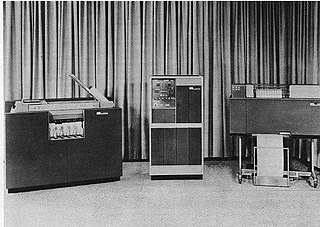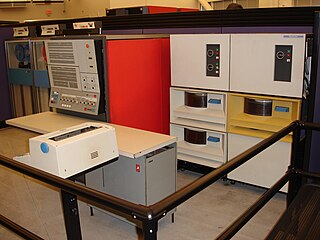IBM mainframes are large computer systems produced by IBM since 1952. During the 1960s and 1970s, IBM dominated the computer market with the 7000 series and the later System/360, followed by the System/370. Current mainframe computers in IBM's line of business computers are developments of the basic design of the System/360.
In processor design, microcode serves as an intermediary layer situated between the central processing unit (CPU) hardware and the programmer-visible instruction set architecture of a computer, also known as its machine code. It consists of a set of hardware-level instructions that implement the higher-level machine code instructions or control internal finite-state machine sequencing in many digital processing components. While microcode is utilized in Intel and AMD general-purpose CPUs in contemporary desktops and laptops, it functions only as a fallback path for scenarios that the faster hardwired control unit is unable to manage.

The IBM System/360 (S/360) is a family of mainframe computer systems announced by IBM on April 7, 1964, and delivered between 1965 and 1978. System/360 was the first family of computers designed to cover both commercial and scientific applications and a complete range of applications from small to large. The design distinguished between architecture and implementation, allowing IBM to release a suite of compatible designs at different prices. All but the only partially compatible Model 44 and the most expensive systems use microcode to implement the instruction set, featuring 8-bit byte addressing and fixed point binary, fixed point decimal and hexadecimal floating-point calculations.

The IBM System/370 (S/370) is a range of IBM mainframe computers announced as the successors to the System/360 family on June 30, 1970. The series mostly maintains backward compatibility with the S/360, allowing an easy migration path for customers; this, plus improved performance, were the dominant themes of the product announcement.

The IBM 1400 series are second-generation (transistor) mid-range business decimal computers that IBM marketed in the early 1960s. The computers were offered to replace tabulating machines like the IBM 407. The 1400-series machines stored information in magnetic cores as variable-length character strings separated on the left by a special bit, called a "wordmark," and on the right by a "record mark." Arithmetic was performed digit-by-digit. Input and output support included punched card, magnetic tape, and high-speed line printers. Disk storage was also available.

The IBM Time Sharing System TSS/360 is a discontinued early time-sharing operating system designed exclusively for a special model of the System/360 line of mainframes, the Model 67. Made available on a trial basis to a limited set of customers in 1967, it was never officially released as a supported product by IBM. TSS pioneered a number of novel features, some of which later appeared in more popular systems such as MVS. TSS was migrated to System/370 and 303x systems, but despite its many advances and novel capabilities, TSS failed to meet expectations and was eventually canceled. The Resident Supervisor of TSS/370 was used as the basis for a port of UNIX to the IBM mainframe. TSS/360 also inspired the development of the TSS/8 operating system.

The IBM System/360 Model 30 was a low-end member of the IBM System/360 family. It was announced on April 7, 1964, shipped in 1965, and withdrawn on October 7, 1977. The Model 30 was designed by IBM's General Systems Division in Endicott, New York, and manufactured in Endicott and other IBM manufacturing sites outside of U.S.

The IBM System/360 Model 67 (S/360-67) was an important IBM mainframe model in the late 1960s. Unlike the rest of the S/360 series, it included features to facilitate time-sharing applications, notably a Dynamic Address Translation unit, the "DAT box", to support virtual memory, 32-bit addressing and the 2846 Channel Controller to allow sharing channels between processors. The S/360-67 was otherwise compatible with the rest of the S/360 series.
The history of IBM mainframe operating systems is significant within the history of mainframe operating systems, because of IBM's long-standing position as the world's largest hardware supplier of mainframe computers. IBM mainframes run operating systems supplied by IBM and by third parties.

OS/360, officially known as IBM System/360 Operating System, is a discontinued batch processing operating system developed by IBM for their then-new System/360 mainframe computer, announced in 1964; it was influenced by the earlier IBSYS/IBJOB and Input/Output Control System (IOCS) packages for the IBM 7090/7094 and even more so by the PR155 Operating System for the IBM 1410/7010 processors. It was one of the earliest operating systems to require the computer hardware to include at least one direct access storage device.

System Generation (SysGen) is a two-stage process for installing or updating OS/360, OS/VS1, OS/VS2 (SVS), OS/VS2 (MVS) and chargeable systems derived from them. There are similar processes for, e.g., DOS/360, which this article does not cover. Also, some of the details have changed between releases of OS/360 and many details do not carry over to later systems.
The IBM 2361 Large Capacity Storage (LCS) is an optional component of the IBM System/360 models 50, 65 (when not being used as a multiprocessor), and 75 computers. Storage is implemented using magnetic cores; the cycle time is 8 microseconds and the access time is 3.6 microseconds. This component is also called IBM 2361 Core Storage or IBM 2361 Large Core Storage. It provides additional main storage with a slower access time than the standard storage of the machine—for example 8 microseconds compared to 750 nanoseconds for main storage on the Model 65.
The IBM Administrative Terminal System (ATS/360) provided text- and data-management tools for working with documents to users of IBM System/360 systems.

The IBM System/360 Model 50 is a member of the IBM System/360 family of computers. The Model 50 was announced in April 1964 with the other initial models of the family, and first shipped in August 1965 to the Bank of America.

The IBM System/360 Model 65 is a member of the IBM System/360 family of computers. It was announced April 1965, and replaced two models, the Model 60 and Model 62, announced one year prior but never shipped. It was discontinued in March 1974.

The IBM System/360 Model 25 is a low-end member of the IBM System/360 family. It was announced on January 3, 1968, 3 years before the IBM System/360 Model 22, as a "bridge between its old and new computing systems".

The IBM System/360 Model 85 is a high-end member of the System/360 family of computers, with many advanced features, and was announced in January 1968 and first shipped in December 1969. IBM built only about 30 360/85 systems because of "a recession in progress".

The IBM System/370 Model 165 were jointly announced June 30, 1970 as "designed for ... the Seventies." That same day IBM announced the 370/195. They were the first three models of the IBM System/370 line of computers.

The IBM System/370 Model 135 was announced March 8, 1971, the only 370 introduced that year. The 135 was IBM's fifth System 370, and it was withdrawn October 16, 1979.















